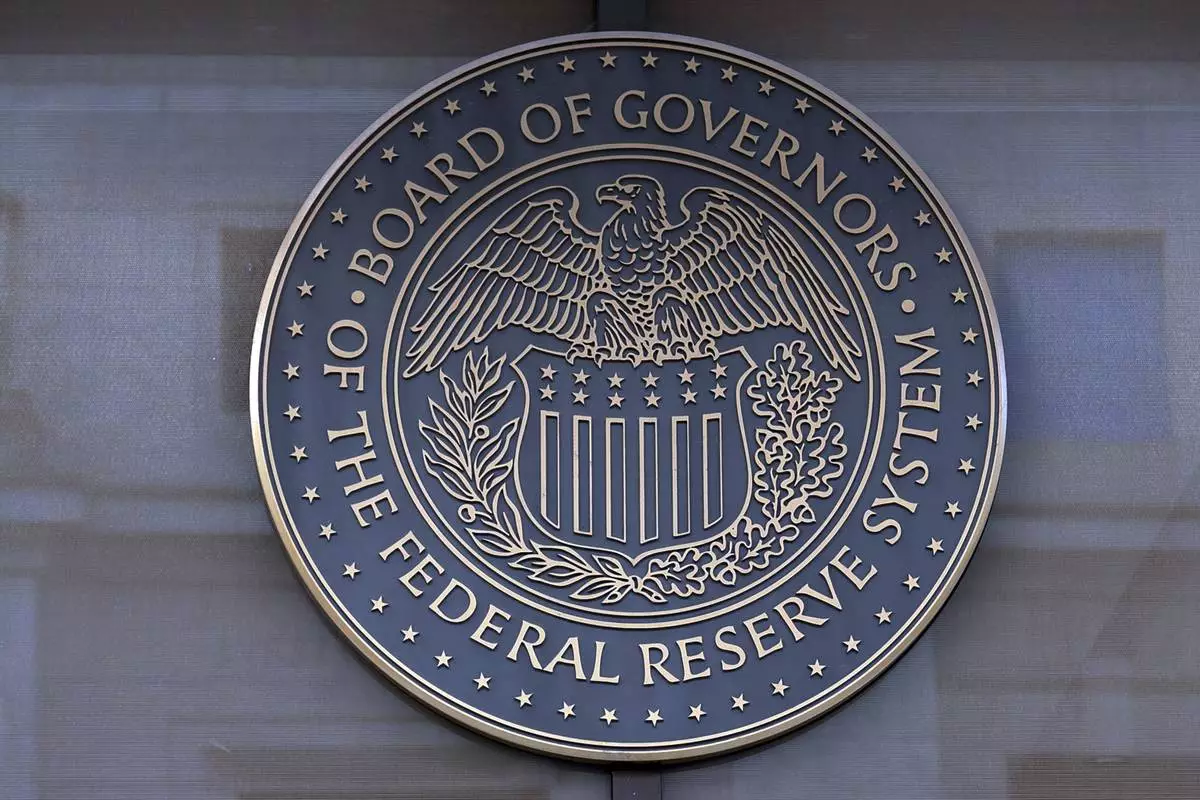NEW YORK (AP) — The Federal Reserve's third interest rate cut of the year will likely have consequences for debt, savings, auto loans, mortgages and other forms of borrowing by consumers and businesses.
But with inflation pressures still elevated and with concern that President-elect Donald Trump's policies could fuel inflation, the Fed indicated Wednesday that it's likely to cut rates more gradually in 2025 than it had projected three months ago. The policymakers now envision two rate cuts next year, not the four they predicted back in September.
The result is that borrowers who have been hoping for much-lower-rate loans could be disappointed. Loan rates may barely budge if the Fed sticks with its plan to cut its key short-term rate only twice next year.
“This could be the last cut for a while,” said Jacob Channel, senior economist for LendingTree. “Because the upcoming Trump administration’s policies might cause a resurgence in inflation or otherwise throw the economy off balance, the Fed might choose to take a wait-and-see approach and hold rates steady at their January meeting.”
Depending on the specific proposals the Trump administration manages to enact, the Fed could hold off on any additional cuts until March or even later.
Here's what to know:
“Another rate cut is welcome news at the end of a chaotic year, but it ultimately doesn’t amount to much for those with debt,” said Matt Schulz, chief credit analyst at LendingTree. “A quarter-point reduction may knock a dollar or two off your monthly debt payment. It certainly doesn’t change the fact that the best thing cardholders can do in 2025 is to take matters into their own hands when it comes to high interest rates.”
The average annual percentage rate on a new credit card offer, according to LendingTree, is 24.43%. In September, it was 24.92%. Further modest declines in that rate, Schulz said, are possible in the next few months.
But, he cautioned, “Anyone expecting card rates to go from awful to amazing overnight because of the Fed is going to be sorely disappointed.”
Elizabeth Renter, senior economist at NerdWallet, said that particularly for credit card users who carry debt from month to month, “It’s a drop in the bucket for anyone feeling pressure from high rates.”
For savers, returns on high-yield accounts have dropped, too, in tandem with the Fed's rate cuts. So while these accounts are not quite as attractive as they had been, they might still be worth investigating if you haven’t shopped for one recently. Some of these accounts offer yields at or near 5%.
“Yes, you’ve missed the peak rates seen a few months ago," Schulz said. “But even at these levels, they’re still likely higher than what you’ll find at a traditional bank.”
Though the Fed doesn’t set mortgage rates, it does influence them. Long-term mortgage rates generally track the yield on the 10-year Treasury note, which, in turn, is driven in part by the market's outlook for inflation and the Fed's benchmark rate.
That means that, at least indirectly, cuts to the Fed’s key rate can put downward pressure on mortgage rates, even if they don’t move in lockstep.
“Case in point, turmoil in the bond market has caused mortgage rates to yo-yo up and down over the last month,” Channel said. “After peaking at 6.84% for the week ending Nov. 21, the average rate on a 30-year fixed-rate mortgage has since come down to 6.60%.”
Despite this decline, this average remains well above the 2024 low of 6.08%, back in late September.
For people with fixed mortgages, their rate won’t change unless they refinance their mortgage or sell and move someplace else.
The effects of the Fed’s half-point rate cut in September and its quarter-point cut in November have largely been passed through to auto loans, which fell on average from a peak of 7.3% in July to 6.8% last month, said Ivan Drury, director of insights for Edmunds.com.
The half-point drop, he said, has helped more people afford new vehicles, helping to spur a buying spree in November. But the increased demand, which Drury attributed largely to some optimism over Trump's election, also boosted average prices and monthly payments to record levels.
“Optimism and having money on hand to do these things has definitely green-lit some people’s spending, when other folks are more conservative with how much they’re spending,” he said.
The average amount that a car buyer financed rose to $42,160, and average monthly payments hit $753, according to Edmunds data.
Edmunds expects only a modest increase in auto sales next year, from just under 16 million vehicles this year to 16.2 million in 2025.
“The Federal Open Market Committee is in a balancing act — cut (rates) too much and risk inflation resurgence; cut too little and continue to squeeze the labor market," said Renter of NerdWallet.
Gregory Daco, chief economist for EY, suggested that Fed Chair Jerome Powell is reiterating “the familiar metaphor of moving slowly in a dark room full of objects to justify a potential rate cut ‘skip’ at the January meeting.”
“This will favor a gradual easing of policy to observe how the economy and inflation behave, indicating an extremely ‘data-dependent’ approach,” Daco said.
“Remember," Channel said, “the Fed is designed to pivot relatively quickly should something unexpected happen. If the economy shows serious signs of deterioration, we could see bigger and more frequent cuts over the next 12 months.”
On the other hand, he cautioned, "if inflation rears its head and spikes once more, (rate) cuts might be moved off the table.”
AP Auto Writer Tom Krisher contributed to this report from Detroit.
The Associated Press receives support from Charles Schwab Foundation for educational and explanatory reporting to improve financial literacy. The independent foundation is separate from Charles Schwab and Co. Inc. The AP is solely responsible for its journalism.

FILE - The seal of the Federal Reserve Board is seen at the building in Washington, Dec. 8, 2024. (AP Photo/Jose Luis Magana, File)
DUBAI, United Arab Emirates (AP) — A series of intense Israeli airstrikes shook Yemen's rebel-held capital and a port city early Thursday and killed at least nine people, officials said, shortly after a Houthi missile targeted central Israel.
Thursday’s strikes risk further escalating conflict with the Iranian-backed Houthis, whose attacks on the Red Sea corridor have drastically impacted global shipping. The rebels have so far avoided the same level of intense military strikes that have targeted Palestinian militant group Hamas and Lebanon’s Hezbollah, fellow members of Tehran’s self-described “Axis of Resistance.”
Israel's military said that it conducted two waves of strikes in a preplanned operation that began early Thursday and involved 14 fighter jets. The military said the first wave of strikes targeted Houthi infrastructure at the ports of Hodeida, Salif and the Ras Isa oil terminal on the Red Sea.
Then, in a second wave of strikes, the military said its fighter jets targeted Houthi energy infrastructure in Sanaa.
The Houthi-controlled satellite channel al-Masirah said that some of the strikes targeted power stations in the capital, posting videos of flames engulfing one structure, as civil defense workers doused it in water, trying to extinguish the fire.
The channel, citing its correspondent in the port city of Hodeida, said that at least seven people had been killed at Salif, while another two had been killed at the Ras Isa oil terminal. Others suffered wounds at the Hodeida port as well, it said.
An Israeli military statement offered no damage assessment.
Rear Adm. Daniel Hagari, an Israeli military spokesman, said the strikes hit energy and port infrastructure, which he alleged the rebels “have been using in ways that effectively contributed to their military action.”
“I suggest the leaders of the Houthis to see, to understand and remember: Whoever raises a hand against the state of Israel, his hand will be cut off, whoever harms us — will be harmed sevenfold,” Israeli Defense Minister Israel Katz said.
Rebel-held Hodeida, about 145 kilometers (90 miles) southwest of Sanaa, has been key for food shipments into Yemen as its decade-long war has gone on. There's also longstanding suspicion that weapons from Iran have been transferred through the port.
The strikes happened just after Israel's military said that its air force intercepted a missile launched from Yemen before it entered the country’s territory. The waves of strikes on Yemen early Thursday weren't a direct response to the missile hit, said a military official, but rather a preplanned response to months of Houthi aggression. Israel’s fighter jets were already in the air when the missile was launched.
“Rocket and missile sirens were sounded following the possibility of falling debris from the interception,” the Israeli military said. Sirens sounded near Tel Aviv and the surrounding areas, and a large explosion was heard overhead at the time.
In Ramat Gan, a suburb of Tel Aviv, a large piece of shrapnel from the missile collapsed a school building there, without causing any injuries.
The military official said that the Houthis have fired more than 200 missiles and UAVs, or unmanned aerial vehicles, at Israel since Oct. 7, 2023.
Brig. Gen. Yahya Saree, a Houthi military spokesman, claimed the attack hours later in a prerecorded video statement, saying the rebels fired two of its “Palestine” ballistic missiles at Israel.
Israel previously struck Hodeida and its oil infrastructure in July after a Houthi drone attack killed one person and wounded 10 in Tel Aviv. In September, Israel struck Hodeida again, killing at least four people after a rebel missile targeted Israel’s Ben Gurion airport as Prime Minister Benjamin Netanyahu was arriving back to the country.
American forces have also launched a series of strikes on the Houthis over nearly a year because of Houthi attacks on shipping in the Red Sea corridor. On Monday, the U.S. military's Central Command said that it hit “a key command-and-control facility" operated by the Houthis in Sanaa, later identified as the al-Ardi complex once home to the government's Defense Ministry.
But Israel appears to have carried out Thursday's strikes alone. A U.S. military official, speaking on condition of anonymity to discuss the attacks, said that Washington had no part in them. While the U.S. has carried out strikes on the Houthis in the past, it's also balancing the desires of Saudi Arabia to reach a permanent ceasefire in its stalemated war with the rebels.
The Houthis have targeted about 100 merchant vessels with missiles and drones since the Israel-Hamas war in the Gaza Strip started in October 2023 after Hamas' surprise attack on Israel that killed 1,200 people and saw 250 others taken hostage.
Israel's grinding offensive in Gaza has killed more than 45,000 Palestinians, local health officials say. The tally doesn't distinguish between combatants and civilians.
The Houthis have seized one vessel and sunk two in a campaign that has also killed four sailors. Other missiles and drones have either been intercepted by separate U.S.- and European-led coalitions in the Red Sea or failed to reach their targets, which have also included Western military vessels.
The rebels maintain that they target ships linked to Israel, the U.S. or the United Kingdom to force an end to Israel’s campaign against Hamas in Gaza. However, many of the ships attacked have little or no connection to the conflict, including some bound for Iran.
The Houthis have battled the Saudi-led coalition in the wider Yemen war, which has killed more than 150,000 people, including civilians. The conflict also has created one of the world’s worst humanitarian disasters that's believed to have killed tens of thousands more.
But the Houthis are still standing even as Israel's campaign against Hamas and Hezbollah has decimated those militant groups. Meanwhile, Israel and Iran have exchanged direct fire while the government of Syria, an enemy of Israel since its founding in 1948, collapsed in the face of a rebel advance as the region’s wars have upended Iran’s network of allied proxy groups.

An officer from the home front command military unit examines the damaged after a large piece of shrapnel from Houthi missile collapsed a school building in Ramat Gan, a suburb of Tel Aviv, Israel, Thursday, Dec. 19, 2024. (AP Photo/Ariel Schalit)

An officer from the home front command military unit and a policeman examine the damage after a large piece of shrapnel from Houthi missile collapsed a school building in Ramat Gan, a suburb of Tel Aviv, Israel, Thursday, Dec. 19, 2024. (AP Photo/Ariel Schalit)

An officer from the home front command military unit examines the damage after a large piece of shrapnel from Houthi missile collapsed a school building in Ramat Gan, a suburb of Tel Aviv, Israel, Thursday, Dec. 19, 2024. (AP Photo/Ariel Schalit)













